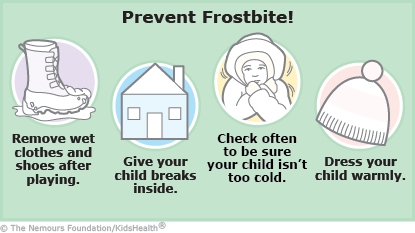Frostbite is a skin injury that happens when skin is exposed to freezing temperatures. Sometimes the cold also injures deeper tissue. Serious frostbite can go all the way down to the muscles and bones. Frostbite is common in kids because they lose heat from their bodies more quickly than adults do. Also, kids often get wet while playing in snow and resist taking breaks while having fun.
After warming up the affected areas and checking how severe the frostbite is, the health care provider likely gave your child medicine to decrease damage to the tissues and to treat pain. To prevent infection of the injured area, they may have cleaned and bandaged any wounds, and given a tetanus shot or antibiotics if needed. Here's how to help your child continue healing from frostbite at home.





What is frostnip? Frostnip is a milder form of cold injury. It is the first sign that a person's skin is too cold, and an early warning sign to go inside to warm up. With frostnip, the top layers of skin get cold, red, tingly, or painful. But the symptoms clear up quickly when the skin is warmed up, with no damage to the skin or tissues underneath. Frostbite happens if a person with frostnip doesn't warm up, and the skin (and sometimes deeper layers) gets frozen and damaged. Frostbitten skin loses color and feeling and may be hard or waxy.
Where is frostbite most likely to happen? The parts of the body that tend to get frostbite most often are the nose, chin, cheeks, ears, fingers, and toes.
What can help prevent frostbite from happening again? After being frostbitten, the skin may be more sensitive to cold for a while. So it will be more important than ever to dress your kids in warm, loose-fitting, waterproof layers of clothing when it's cold out. Be sure to bring them inside for regular warm-up breaks when they're outside playing in cold weather. And always remove wet shoes and clothes when they come in.